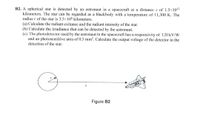Question

Transcribed Image Text:B2. A spherical star is detected by an astronaut in a spacecraft at a distance z of 1.5×10¹2
kilometers. The star can be regarded as a blackbody with a temperature of 11,300 K. The
radius r of the star is 3.5×106 kilometers.
(a) Calculate the radiant exitance and the radiant intensity of the star.
(b) Calculate the irradiance that can be detected by the astronaut.
(c) The photodetector used by the astronaut in the spacecraft has a responsivity of 120 kV/W
and an photosensitive area of 0.5 mm². Calculate the output voltage of the detector in the
detection of the star.
CAMINS
+II+
Figure B2
Expert Solution
This question has been solved!
Explore an expertly crafted, step-by-step solution for a thorough understanding of key concepts.
This is a popular solution
Trending nowThis is a popular solution!
Step by stepSolved in 3 steps with 3 images

Knowledge Booster
Similar questions
- The sun has a luminosity of 3.9 × 1026 W and an angular diameter of θ = 32 arc mins. Assume that the sun is a blackbody. What is its physical radius and its effective temperature?arrow_forward2. Model the tungsten filament of a lightbulb as a blackbody at temperature 2 900 K. Determine the wavelength of light it emits most strongly.arrow_forwardSuppose YOUR body temperature averages 98.6 F. 1. How much radiant energy in Wm^-2 is emitted from YOUR body? 2. What is the total radiant energy in W that is emitted from YOUR body? 3. At what wavelength does YOUR body emit the largest amount of radiant energy?arrow_forward
- 1. If the maximum wavelength in the sun spectrum Amax =480 nm and a = 2.89x103 K.m calculate the sun surface temperaturearrow_forwardSolve correctly in 30 minutesarrow_forward2) Interstellar dust radiate most of its energy at 100 μm. Assuming the dust to be a blackbody estimate the temperature of the interstellar dust. (arrow_forward
- 1. A cube of iron (atomic number 26), whose side measures 1 ft (30.48cm), is floating in a dark space. It is observed to emit blackbody radiation at the power of 200oW. (a) Would you dare to touch it for $20? Find the temperature of the cube before you answer. (b) Find the peak frequency of the spectrum, and compute the energy of photon at the frequency. Give the energy in units of electron-volt (eV). (c) What would be the temperature for the radiation if the cube were made of alu- minum (atomic number 13)?arrow_forwardIf a star gives off light at a peak wavelength of 6.80x10-7 m. What would be the temperature of this star in Kelvin?arrow_forward1. Calculate the energy of a photon whose frequency is (a) 5.00×10¹4 Hz, (b) 10.0 GHz, (c) 30.0 MHz. Express your answers in electron volts.arrow_forward
- Calculate the wavelength of a photon having an energy of 5.89 x 10^11 J of energy. E = hc/λ You must show a correct numerical setup and your answer must include the correct mathematical unit.arrow_forward2. The wavelength of maximum intensity of the sun's radiation is observed to be near 500 nm. Assume the sun to be a black-body and calculate,imsed of (a) the sun's surface temperature (b) the power per unit area (intensity) emitted from he sun's surface. (c) At what rate is the sun losing mass in units of kg/s? (Hint: What are the units from rignslavaw wert odrai Jari W (d) your answer in part (b)?) (d) At that rate, how much time would it take to exhaust the sun's fuel supply? Does your answer seem reasonable? (The sun's mass is ~2.0x1030 kg)arrow_forwardFastarrow_forward
arrow_back_ios
SEE MORE QUESTIONS
arrow_forward_ios